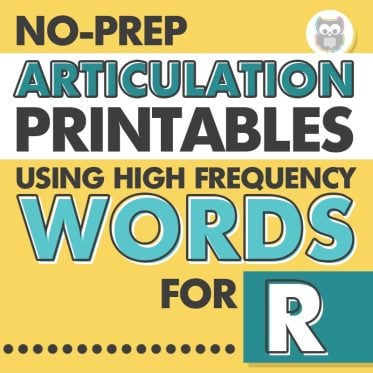If you’re like most SLPs, you are in need of some pronouns speech therapy activities! Pronouns are actually the #2 most common grammar target amongst elementary school SLPs, so it’s a pretty common need.
Children start using pronouns at 3-4 years of age. They don’t perfect them then, though. It isn’t until 3rd grade that pronouns show up as an English Language Art Common Core Standard, when students are expected to use correct gender agreement with pronouns.
How to Target Pronouns in Speech Therapy
Smith-Lock, Leitao, Lambert, & Nickels (2013) have given us a great method to target pronouns, following these steps during play-based small groups of 3-6 children:
- Explicitly and directly teach the target
You can use language like “when we talk about boys, we say ‘he’ and when we talk about girls, we say ‘she’.”
2. Model the target.
Emphasize the target in your model sentence.
3. Ask a question to elicit the grammatical target.
4. Correct errors
- If the child produces an error, give them a chance to repeat themself and possible correct themselves.
- In case of a repeated error, model the correct answer (recasting), with slight emphasis on the target and give the child a chance to try again.
- If they are still in error, model the structure, then tell the child “you say that”
5. Acknowledge correct productions
After the child gives a correct production (even if they just had to repeat your model) tell them they got it and model the correct response again.
Selecting specific targets, repeated modelling, multiple opportunities to produce targets, giving feedback, and giving opportunity for correction.
PRO TIP: Have you ever had a hard time getting a child to use your targeted pronoun? Like they say “The girl is eating” instead of “She is eating”? The authors found that if they just asked “why?,” children typically answered with the pronoun, instead of “the girl” again.
Other Helpful Tips When Targeting Pronouns
When you’re using recasts, you want to use about 1 recast per minute for most effective therapy.
There is no research on whether small groups, individual therapy, providing service in therapy rooms, or the classroom is best!
Explicit instruction is recommended when targeting grammatical forms.
Measure progress using language samples. Don’t use TTR (type token ratios) to measure progress because it isn’t sensitive to change over time.
Gender-Neutral Pronouns in Speech Therapy
More recently, gender neutral pronouns have entered mainstream consciousness. SLPs might feel confused or uncertain about how and maybe even if they should target gender-neutral pronouns with their students.
Shotwell and Sheng (2021) recently provided guidance to SLPs regarding the use and teaching of gender-neutral pronouns.
Transgender and nonbinary youth who have their pronouns respected by almost all people in their lives attempt suicide at nearly half the rates of their peers who did not.
Our scope of practice includes pronoun intervention, including pronouns used culturally and community appropriate pronouns. At this point, in the United States at least, this includes gender-neutral pronouns. The ASHA Code of Ethics dictates that SLPs not discriminate based on gender identity. It is our responsibility to help children functionally communicate. Therefore, it is both within our scope of practice, as well as ethically-bound to provide gender-neutral intervention for our students who may have nonbinary classmates, teachers, and family members.
The interesting thing is that when you take into account gender-neutral pronouns, intervention of pronouns encompasses three components of language!
Pronouns require morph-syntax knowledge because plural and singular pronouns can change the verb. While this occurs with gender-specific pronouns, using “they” as both a singular and plural pronoun changes the rules a little bit. “They are” can refer to a group or an individual.
Pronouns also require semantic knowledge. We need to know which pronoun to use and in what contexts.
You can include gender-neutral materials in your assessment to see if your students have needs in this area.
If you are familiar with the Test of Narrative Development – 2nd Edition (TNL-2), you might have noticed that one of the children in the alien picture scene is seemingly gender-neutral. I don’t think the editors necessarily did this on purpose, but I have heard my students refer to one of the characters as both “he” and “she”. I have even had students ask me if the character was a girl or a boy before they start telling me the story. This could be an interesting place to start when considering the use of nonbinary pronouns.
Pronouns Sentence Sliders: Digital Speech Therapy Activity
Now, if you’re ready to target some pronouns but looking for some speech therapy activities and ready-made materials, you’re in luck!
My Pronouns Sentence Sliders: Digital Speech Therapy Activity is perfect for no-prep, no-print therapy, available in different levels so you can meet your students where they are!
Level one includes icon-based sentence formulation activities.
My teaching pages explain what pronouns are and how to ask to learn someone’s pronouns. There are pages specifically used to learn how and when to use “they” as a pronoun to describe groups of people, unknown people, and people when we don’t know their pronouns.
The level one practice pages include color-coded drag-and-drop icons to formulate sentences about singular male, female, and non-binary people. Each person is introduced with their name and pronouns. Then your student can practice making sentences about that person.
Level two is a high level, text-based, more advanced companion.
It includes more practice on objective and possessive pronouns.
All 199 pages of this amazing product are available as Boom Cards, Google Slides, and PowerPoint formats!
Do you have any other pronouns based speech therapy activities? I’d love to hear!
References
Shotwell, S. & Sheng, L. (2021). Making a case for studying gender-neutral pronouns in speech-language pathology. Language, Speech, and Hearing Services in Schools. https://doi.org/10.1044/2021_LSHSS-21-00021
























Leave a Comment